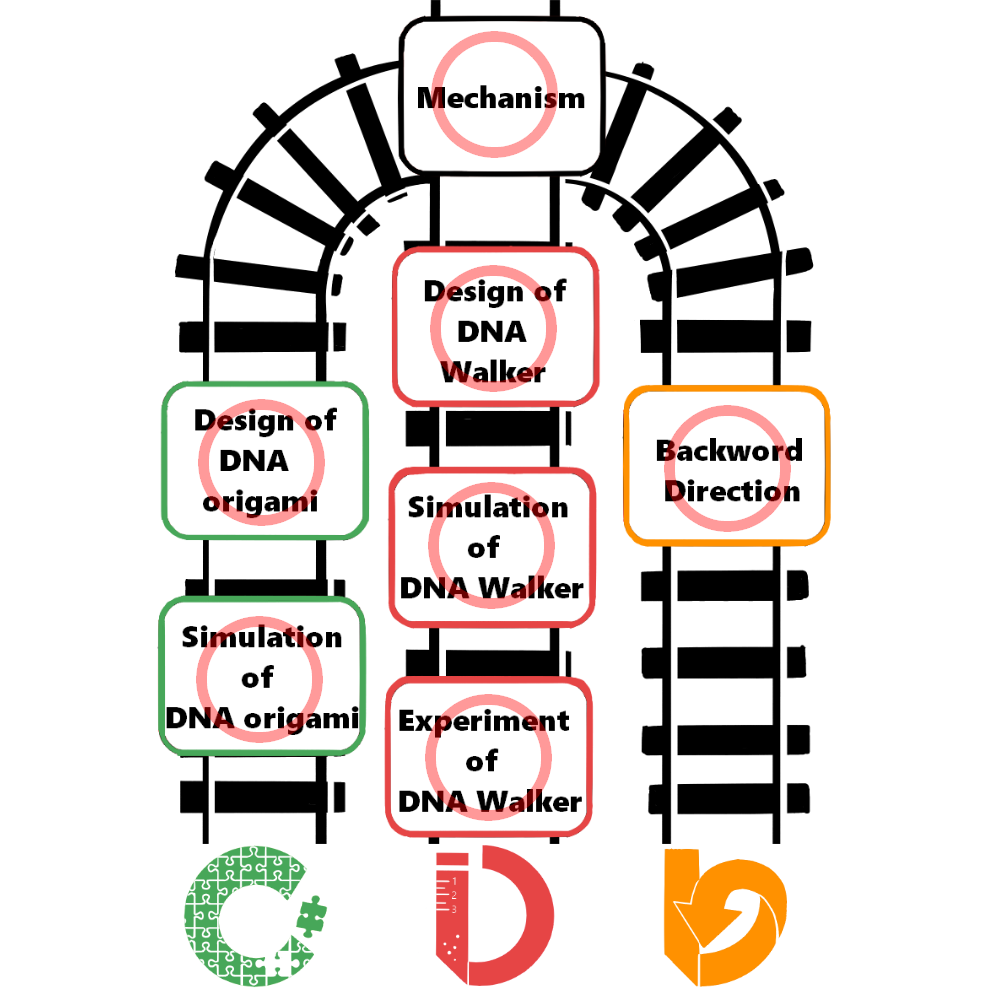
Abstract
Here, we propose a method for the development of DNA nanostructures that autonomously move in a single direction. A structure called a DNA Walker[9], in which two DNA strands were partially bound and a single-stranded region was present at both ends of the double-stranded portion, was used in this method. The DNA Walker ran on double-stranded DNA (Ground) in which single-stranded DNA (Spot) of the same base sequence with a hairpin structure was continuously arranged. The DNA Walker used its single-strand region as a toehold, induced a strand displacement reaction at a particular Spot, and then moved to the next Spot. Next, the strand displacement reaction between the DNA Walker and Spot occurred again, and the DNA Walker spontaneously traveled on the Ground. Since the progress of the DNA Walker depended on the initial concentration of fuel DNA, progress could be controlled by adjusting the initial concentration. We added mismatched base pairs to the nucleotide sequence of the DNA Walker to avoid an unintended reaction pathway. In addition, we changed the structure of the DNA Walker to connect to the DNA origami, making it available as a force to move the DNA origami structure; accordingly, this portion was designated the “Transporter”.
Our Project
We humankind has invented a variety of transporting machines, which support our daily lives as an underlying technology. We believe thatif we can carry objects also in the nano world we think we will be able to benefit even more. Therefore, in BIOMOD project, we created a system that carries things with DNAWalker as a power source. Since unwanted reactions occurred in conventional DNA walkers, there was a possibility that Walker could leave the ground, so by adding a mismatch base sequence to DNAWalker with Transporter, letting the reaction rate change without causing undesired reactions , we thought about design that Walker will not release from Ground. Experiments A and B confirmed that undesirable reactions did not occur by adding mismatched base sequences, made Ground and Walker by Experiments C and D, and actually did not leave the Walker from Ground in Experiment E we confirmed that the reaction progressed as we expected.
Project Idea
We created a system that functioned as a power source for moving DNA structures. We considered a system in which the structure to be moved and the power source were separate, rather than one in which the DNA structure to be moved and its power source were united. In this framework, even if the DNA structure was changed according to the specifications of the application, movement was possible as long as a connection with the power source was made. Therefore, the aim of this project was to design a system that functioned as a power source. The proposed power source must satisfy the following three specifications. First, this system must be able to adjust its progress. Second, this system must be able to connect to the target DNA structure. Third, since DNA molecules are in Brownian motion in solution, they move in all directions; therefore, this system should move in a single direction. Accordingly, we built a system that satisfied these three specifications with reference to the principle of operation of a structure called a DNA Walker [9].
References
[1] D. Zhan and E. Winfree: Control of DNA strand displacement kinetics using toehold exchange, J. Am. Chem. Soc., Vol. 131, pp. 17303-17314, 2009.
[2] S. Kobayashi, K. Yanagibashi, K. Fujimoto, K. Komiya and M. Hagiya: Analog DNA computing devices toward the control of molecular robots, Workshop on Self-organization in Swarm of Robots: from Molecular Robots to Mobile Agents (WSSR 2014), Nara, October, 2014.
[3] NUPACK: http://www.nupack.org
[4] D. W. Bo Broadwater, et. al., The effect of base pair mismatch on DNA strand displacement, Biophysical j., 110 (7), 1476, 2016.
[5] Yuki Yoshida, Takashi Nakakuki, Design tool of DNA base sequences for molecular circuits, Proc. of 17th International Conference on Control, Automation and Systems (ICCAS 2017), Oct, 2017.
[6] cadnano: http://cadnano.org
[7] Cando: https://cando-dna-origami.org
[8] Matlab: https://jp.mathworks.com/products/matlab.html
[9] P. Yin, H. Choi, C. Calvert, N. Pierce: Programming biomolecular self-assembly pathways, Nature, Vol. 451, pp. 318, 2008.



